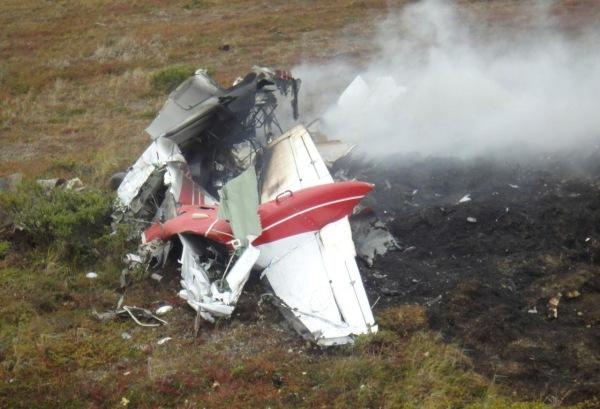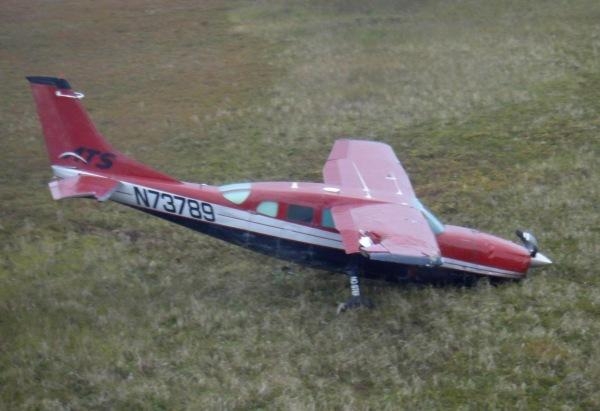One Pilot Fatally Injured In Accident Near Nightmute, AK
 "See and Avoid" is one of aviation's cardinal rules. The
NTSB's preliminary report in an accident which occurred September
2nd near Nightmute, AK, details a situation where that basic
concept appears to have broken down, resulting in the fatal injury
of one pilot. It serves to remind us why our primary flight
instructors constantly rode us to "keep your head on a swivel."
"See and Avoid" is one of aviation's cardinal rules. The
NTSB's preliminary report in an accident which occurred September
2nd near Nightmute, AK, details a situation where that basic
concept appears to have broken down, resulting in the fatal injury
of one pilot. It serves to remind us why our primary flight
instructors constantly rode us to "keep your head on a swivel."
NTSB Identification: ANC11FA091A, ANC11FA091B
Nonscheduled 14 CFR Part 135: Air Taxi & Commuter
Accident occurred Friday, September 02, 2011 in Nightmute, AK
Aircraft: CESSNA 208B, registration: N207DR
Aircraft: CESSNA T207A, registration: N73789
Injuries: 1 Fatal,1 Uninjured.
This is preliminary information, subject to change, and may
contain errors. Any errors in this report will be corrected when
the final report has been completed.
Accident Cessna 208 Alaska State Patrol
Photo

On September 2, 2011, about 1335 Alaska daylight time, a Cessna
208B (Caravan) airplane, N207DR, and a Cessna 207 airplane, N73789,
collided in midair, approximately 9 miles north of Nightmute,
Alaska. Both airplanes were being operated as visual flight rules
(VFR) charter flights under 14, CFR Part 135, in visual
meteorological conditions when the accident occurred. The Cessna
208B was operated by Grant Aviation Inc., Anchorage, Alaska, and
the Cessna 207 was operated by Ryan Air, Anchorage, Alaska. The
sole occupant of the Cessna 208B, an airline transport pilot,
sustained fatal injuries. The sole occupant of the Cessna 207, a
commercial pilot, was uninjured. Both airplanes sustained
substantial damage during the midair collision. After the
collision, the Cessna 208B descended, uncontrolled, and impacted
tundra-covered terrain. A postcrash fire consumed most of the
wreckage. The Cessna 207 was further damaged during a forced
landing on tundra-covered terrain. Both airplanes were based at the
Bethel Airport, Bethel, Alaska. The Cessna 208B departed from the
Toksook Bay Airport about 1325, and VFR company flight following
procedures were in effect for the flight to Bethel. The Cessna 207
departed from the Tununak Airport, Tununak, Alaska, about 1315, and
VFR company flight following procedures were in effect for the
return flight to Bethel.
During separate telephone conversations with the National
Transportation Safety Board (NTSB) investigator-in-charge on
September 2, the chief pilot for Ryan Air, as well as the director
of operations for Grant Aviation, independently reported that both
pilots had a close personal relationship.
During an initial interview with the NTSB IIC on September 3, in
Bethel, the pilot of the Cessna 207 reported that both airplanes
departed from the neighboring Alaskan villages about the same time,
and both airplanes were en route to Bethel along similar flight
routes. She said that just after takeoff from Tununak, she talked
with the pilot of the Cessna 208B on a prearranged, discreet radio
frequency, and the two agreed to rendezvous for the flight back to
Bethel. She said that while in cruise level flight at 1,200 feet
msl, en route to Bethel, the pilot of the Cessna 208B flew his
airplane along the left side of her airplane, and they continued to
talk via radio. She said that the pilot of the 208B then
unexpectantly and unannounced climbed his airplane above, and
overtop of her airplane. She immediately told the pilot of the 208B
that she could not see him, and she was concerned about where he
was. She said the 208B pilot then said, in part: "Whatever you do,
don't pull up." Moments later, the next thing she recalls was the
208B's impact with her airplane's right wing.
Accident Cessna 207 Alaska State Patrol
Photo

The 207 pilot reported that after the impact, she saw the 208B
pass underneath her airplane, and it began a gradual descent, which
steepened as the airplane continued to the left and away from her
airplane. She said that she told the pilot of the 208B that she
thought she was going to crash. The pilot of the 208B stated that
he also thought he was going to crash. She said that she watched as
the 208B continued to descend, then it entered a steep, vertical,
nose down descent, before it collided with the ground. She said a
postcrash fire started instantaneously upon impact.
The 207 pilot said that while struggling to maintain control of
her airplane, she was unable to maintain altitude, and she selected
an area of rolling, tundra-covered terrain as a forced landing
site. She said that during the emergency descent, she had limited
roll control, and the airplane's stall horn was on during the
entire emergency approach. The airplane touched down on the soft
terrain, and the nose landing gear collapsed.
On September 3, the NTSB IIC, along with an Alaska State
Trooper, and a Federal Aviation Administration operations inspector
from the Anchorage Flight Standards District Office (FSDO),
examined the wreckage sites. The wreckage of the Cessna 207 was
located about 1 mile to the east of the Cessna 208B. Both aircraft
came to rest in an area of tundra-covered, hilly terrain.
The Cessna 208B's severed vertical stabilizer and rudder
assemblies were found about one-half mile west of the main wreckage
site, and along the two airplanes' reported flight route. A large
portion of the Cessna 207's right aileron was found near the 208's
rudder and stabilizer.
 Airbus Racer Helicopter Demonstrator First Flight Part of Clean Sky 2 Initiative
Airbus Racer Helicopter Demonstrator First Flight Part of Clean Sky 2 Initiative Diamond's Electric DA40 Finds Fans at Dübendorf
Diamond's Electric DA40 Finds Fans at Dübendorf ANN's Daily Aero-Term (04.23.24): Line Up And Wait (LUAW)
ANN's Daily Aero-Term (04.23.24): Line Up And Wait (LUAW) NTSB Final Report: Extra Flugzeugbau GMBH EA300/L
NTSB Final Report: Extra Flugzeugbau GMBH EA300/L Classic Aero-TV: 'Never Give Up' - Advice From Two of FedEx's Female Captains
Classic Aero-TV: 'Never Give Up' - Advice From Two of FedEx's Female Captains





